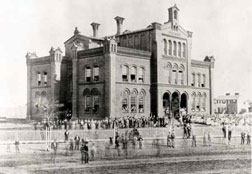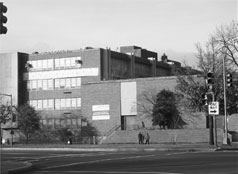Construction is starting on a mixed-use building at Eastern Market. It took seven years to get this far.
In a ceremony on Friday, a mixed-use development formally broke ground at where the closed Hine Junior High School used to stand, across the street from Eastern Market Metro. This hard-fought project has been in the works since at least 2008, and is a good example of how long many of these projects can take amid community battles.
Here’s a quick chronology of the Hine project that covers some, but definitely not all, of the steps:
1864: A beautiful building is constructed for the Wallach School along Pennsylvania Avenue between 7th and 8th.
ca. 1893-1938: Some other school buildings start filling in more of the square, including one for a new public high school and junior high, the latter called Hine.
1950: The Wallach building is torn down.
1966: The Hine school is built, covering most of the entire block from 7th to 8th, Pennsylvania to C. The parking lot on the north side also spans where a closed C Street used to be. Its design relates poorly to the surrounding streets and it forms a dead zone between the Eastern Market and Barracks Row commercial areas.
1993: The flea market at Eastern Market starts using the Hine parking lot.
2007: The Hine school closes. Discussions begin about redeveloping the site.
May 2008: Councilmember Tommy Wells hosts a preliminary community meeting about the redevelopment proposals.
June 2009: Four development teams present their proposals. One proposal, from Stanton and Eastbanc, stands out, David Cranor writes. It’s also the densest.
September 2009: The DC government selects Stanton/Eastbanc’s proposal.
Early 2011: Stanton/Eastbanc go to various community meetings to present their more-detailed proposal. Some nearby residents focus on fighting the overall size of the project, which has sections ranging from four to seven stories (taller on Pennsylvania Avenue, shorter elsewhere). Others who are more supportive of new housing near Metro focus on architectural issues that wouldn’t affect the overall opportunity to add housing.
The Advisory Neighborhood Commission creates a committee to work on Hine, which ultimately supports most of the overall size and advocates for a set of other changes based on community feedback.
April 2011: The project goes to the Historic Preservation Review Board, where many people oppose the height. Preservation staff, however, argue that a building of this size is appropriate for a prominent corner like this one.
2012: The project moves on to the Zoning Commission. The same debates over height continue to rage.
October-November 2012: Hine opponents try to unseat ANC commissioners who supported the committee’s recommendations and didn’t fight the project’s size more fiercely. The incumbents win reelection.
November 2012: The Zoning Commission approves the project. The developers say they are hoping to start construction in summer 2013. Neighbors appeal in court.
August 2014: The DC Court of Appeals rejects the appeal. The opponents petition the court for a rehearing in the case.
November 2014: Some Hine opponents again run for open ANC seats in the two districts nearest the project, but are not elected.
January 2015: The Court of Appeals rejects opponents’ petition and clears the way for Stanton/Eastbanc to begin construction.
June 2015: Demolition begins on the old Hine building.
July 17, 2015: The project formally breaks ground.
June 2017: The first building, on the south side along Pennsylvania Avenue, should open if all goes according to plan.
One thing that stands out from this timeline is how long opponents successfully blocked the project with their court challenge. It took about two years from when Stanton/Eastbanc won the bid until they had all of the necessary approvals; that’s not quick, but not so unusual in DC, and this was a large and complex project with many small changes along the way. Then, the court case blocked progress for almost two more years.
It’s clear that opponents primarily do not want to see mid-sized buildings like these on the site, but one of their arguments was that this site didn’t have enough affordable housing. Unfortunately, the long delay ensured that needed housing, both market-rate and affordable, was not available for a long period of time.






